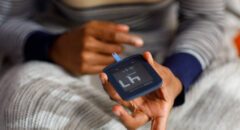
Compared to the general population, African Americans are disproportionately affected by diabetes:
• 4.9 million (an increase from 3.7 million in 2007), or 18.7% of all African Americans, aged 20 years or older, also have diabetes.
• African Americans are 1.8 times more likely to have diabetes as non Hispanic whites.
• 25 percent of African Americans between the ages of 65 and 74 have diabetes.
• 1 in 4 African American women over 55 years of age has diabetes.
While living with diabetes can be a challenge, following some basic guidelines can help you keep your blood sugar under control and avoid diabetic complications and emergencies.
Here are 15 tips for living a healthier life with diabetes:
1. Don't assume that you'll feel when your blood sugar is getting high.
Type 2 diabetes is often a silent disease. You may feel just fine even though chronically high blood sugar levels are doing serious damage to your body. When it comes to monitoring diabetes, don't rely on how you feel. Don't wait until it's advanced enough to cause symptoms.
Every person with diabetes needs to use a home blood glucose monitor to keep tabs on blood sugar. Ask your doctor about how often you need to check your blood sugar. It varies from person to person, depending on your health and the medicines you take.
2. Get enough sleep.
People with type 2 diabetes who don't sleep enough are more likely to feel more nerve pain and have unhealthy blood sugar levels. High levels of stress hormones in the body -- triggered by not getting enough sleep -- can make you hungry for sweets, which can make the problem worse. Studies have found that chronic lack of sleep is a risk factor for developing type 2 diabetes in the first place.
Allow for seven to nine hours of sleep a night. In some cases, diabetes symptoms, such as frequent urination, can make sleep difficult. If you're always overtired, talk to your doctor.
3. Treat cuts and injuries immediately.
You can just use an antibiotic cream and apply a bandage to a wound. Don't let it "air out" -- wounds will heal better if they're kept moist and covered. If you have diabetes, your body heals more slowly and is more prone to infection. Untreated minor cuts can turn into painful wounds that take months, or even years, to heal. Always treat cuts and scrapes, even if they're just shaving nicks or small blisters.
Also, be sure to keep an eye on the injury. If you see signs of infection, call your doctor.
4. Control stress, which can cause your blood sugar to rise.
Stress can be trouble for people with diabetes. First, when you're stressed, you're less likely to take care of yourself. You may eat poorly, stop exercising, or not get enough sleep. Second, stress seems to have a direct effect on blood sugar levels, pushing them out of whack.
Because no one avoids stress completely, learn ways that you can reduce it. Exercise, yoga, and meditation all help cut down on stress. Practice stress-busting deep-breathing techniques that you can use on the go. They can calm you down in the middle of a flap with your teenager or after a stressful meeting with your boss.
5. Exercise regularly.
Exercise has real benefits for people with diabetes. It can lower blood sugar, lower blood pressure, improve your body's use of insulin, and boost heart health. It may even allow you to take lower doses of your medications.
Most experts suggest at least 150 minutes of exercise a week spread out over three days. Remember that all sorts of activities count -- playing tennis, walking, and biking. Splitting your activity into smaller chunks during the day and combining cardio workouts with strength training make it easier.
6. Don't forget to strength train.
In addition to aerobic activity, try to lift weights or practice resistance training two to three times a week. Building muscle won't only make you stronger. It will boost the effectiveness of your natural insulin and improve your blood sugar levels. It also will burn calories and help prevent weight gain.
You don't need to join a gym if you don't want to. Doing calisthenics -- such as push-ups -- or using free weights or resistance bands at home will work.
7. Keep your weight under control.
Extra weight is a risk factor for developing diabetes. It's also a risk factor for some of its serious complications, such as heart disease.
It's easy to get discouraged if you have a lot of weight to lose. But small steps will make a difference. Studies have found that losing even a little weight -- just 5 to 15 pounds -- can lower blood sugar levels. Losing weight also will improve your blood pressure, reduce your risk of heart disease, and boost the effectiveness of insulin.
8. Be aware of how diabetes can affect pregnancies.
Doctors once told women with diabetes to avoid pregnancy. That's not true anymore. With good medical care,...
...women with diabetes can have a normal pregnancy and a healthy baby.
The key is good control of blood sugar levels both during and before pregnancy. To prepare, meet with your doctor three to six months before you start trying to conceive. You'll learn how to have a healthy pregnancy, which means more attention to diet and blood glucose and more adjustments to your treatment.
9. Realize that if you catch the flu, you're more likely to be sicker from it.
If you have diabetes, you are not more likely to get a cold or flu than the average person. But if you do catch a cold or flu, you are more likely to be sicker. Your blood sugar may rise, and you're more likely to have complications. People with diabetes are about three times more likely to die from flu and pneumonia.
So protect yourself. During cold and flu season, wash your hands more often and use an alcohol-based hand sanitizer when you're not near a sink. Always make sure to get your flu shot every year, preferably in September, before flu season starts. Make sure you're up-to-date on your pneumonia shot, too.
10. Aim for no more than a teaspoon of sodium a day.
Cutting down on salt is important for people with diabetes. It can help keep blood pressure under control, protect the kidneys, and lower the risk of heart disease. People with diabetes should aim for about two-thirds of a teaspoon of table salt a day. Unfortunately, the average American eats more than three to nine times that amount.
Reducing salt isn't as simple as taking the salt shaker off the table (although that's a good idea.) You also need to cut down on processed foods, which tend to be chock full of salt. When cooking, try using herbs to add flavor to your food instead of salt.
11. Watch your fruit intake.
Yes, fruits are a key part of a healthy diet. But fruits do contain carbs -- some more than others -- and eating too many carbs could cause your blood sugar to get too high. As with any food, pay attention to the amount you're eating.
In general, opt for smaller pieces of fruit and choose whole fruit over juices. Also, control servings of starchy vegetables, such as potatoes, yams, peas, and corn. Talk to your doctor or a dietitian to get a good sense of a healthy meal plan for you.
12. Don't assume what you can and can't eat.
People with diabetes can eat anything they want -- candy, cupcakes, apple pie, or other sweets. As long as your portions are reasonable, there are no forbidden foods. The key is to eat sweets in moderation, plan ahead, and watch your total carbs. For instance, if you want to have a small piece of cake for dessert, compensate by skipping another food with carbs.
Keep in mind that many "diabetic" candies and other sweets, which are sugar-free, still have calories and carbs that can affect your blood sugar. Even if a product is marketed for people with diabetes, never assume it's safe to eat an unlimited amount.
13. Eat healthy fats.
Reduce unhealthy saturated and trans fats, such as the kinds found in processed foods, but make sure you're getting enough healthy monounsaturated and polyunsaturated fats. Reducing saturated fats will lower your risk of cardiovascular disease, a serious complication of diabetes.
So swap a handful of almonds -- high in healthy fats -- for a slice of cheese. Choose salmon instead of a burger. Moderation is still important because even healthy fats are high in calories. Eat too much and you'll gain weight.
14. Wear comfortable shoes as often as possible.
People with diabetes can develop serious foot problems. Because of nerve damage, they may not feel a blister or sore. Poor blood flow to the feet can make the injury slower to heal and more likely to become infected. Having diabetes can mean you are more prone to infections and can lower your defenses to healing. Wearing worn-out, tight, or poorly made shoes increases the danger.
You don't necessarily need to buy special orthopedic "diabetes shoes." But invest in good shoes and sneakers that fit well and have enough room, especially in the toe box. Every night before bed, check your feet for any new sores, blisters, or irritation.
15. Get the A1c test.
In most cases, it's fine for diabetics to be tested two to four times a year. A1c tests give you key information about your glucose levels beyond regular blood sugar tests and standard fasting tests. Instead of just a snapshot of how you're doing at a given moment, A1c tests give you an overall picture of your blood sugar control over the past two to three months.
Because they provide a big picture, you don't need A1c tests all the time. Two to four times a year is the standard. However, it's best to consult with your doctor first.








